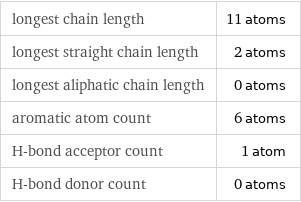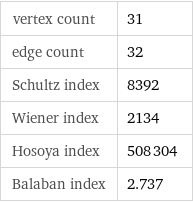Input interpretation

(4-(1-piperidinylmethyl)phenyl)magnesium bromide
Basic properties
![molar mass | 278.5 g/mol formula | C_12H_16BrMgN empirical formula | N_C_12Mg_Br_H_16 SMILES identifier | C1CCN(CC1)CC2=CC=C(C=C2)[Mg]Br InChI identifier | InChI=1/C12H16N.BrH.Mg/c1-3-7-12(8-4-1)11-13-9-5-2-6-10-13;;/h3-4, 7-8H, 2, 5-6, 9-11H2;1H;/q;;+1/p-1/fC12H16N.Br.Mg/h;1h;/q;-1;m InChI key | IHERGHRULIMGJW-UHFFFAOYSA-M](../image_source/a9a559f49bddfaf851a8410d2ae31255.png)
molar mass | 278.5 g/mol formula | C_12H_16BrMgN empirical formula | N_C_12Mg_Br_H_16 SMILES identifier | C1CCN(CC1)CC2=CC=C(C=C2)[Mg]Br InChI identifier | InChI=1/C12H16N.BrH.Mg/c1-3-7-12(8-4-1)11-13-9-5-2-6-10-13;;/h3-4, 7-8H, 2, 5-6, 9-11H2;1H;/q;;+1/p-1/fC12H16N.Br.Mg/h;1h;/q;-1;m InChI key | IHERGHRULIMGJW-UHFFFAOYSA-M
Lewis structure

Draw the Lewis structure of (4-(1-piperidinylmethyl)phenyl)magnesium bromide. Start by drawing the overall structure of the molecule, ignoring potential double and triple bonds: Count the total valence electrons of the bromine (n_Br, val = 7), carbon (n_C, val = 4), hydrogen (n_H, val = 1), magnesium (n_Mg, val = 2), and nitrogen (n_N, val = 5) atoms: n_Br, val + 12 n_C, val + 16 n_H, val + n_Mg, val + n_N, val = 78 Calculate the number of electrons needed to completely fill the valence shells for bromine (n_Br, full = 8), carbon (n_C, full = 8), hydrogen (n_H, full = 2), magnesium (n_Mg, full = 4), and nitrogen (n_N, full = 8): n_Br, full + 12 n_C, full + 16 n_H, full + n_Mg, full + n_N, full = 148 Subtracting these two numbers shows that 148 - 78 = 70 bonding electrons are needed. Each bond has two electrons, so in addition to the 32 bonds already present in the diagram add 3 bonds. To minimize formal charge carbon wants 4 bonds. Identify the atoms that want additional bonds and the number of electrons remaining on each atom: Fill in the 3 bonds by pairing electrons between adjacent highlighted atoms. Note that the six atom ring is aromatic, so that the single and double bonds may be rearranged: Answer: | |
Quantitative molecular descriptors

longest chain length | 11 atoms longest straight chain length | 2 atoms longest aliphatic chain length | 0 atoms aromatic atom count | 6 atoms H-bond acceptor count | 1 atom H-bond donor count | 0 atoms
Elemental composition

Find the elemental composition for (4-(1-piperidinylmethyl)phenyl)magnesium bromide in terms of the atom and mass percents: atom percent = N_i/N_atoms × 100% mass percent = (N_im_i)/m × 100% Plan: • Write the chemical formula and gather atomic masses from the periodic table. • Determine values for N_i, m_i, N_atoms and m using these items. • Finally, compute the percents and check the results. Write the chemical formula: C_12H_16BrMgN Use the chemical formula, C_12H_16BrMgN, to count the number of atoms, N_i, for each element and find the total number of atoms, N_atoms: | number of atoms N (nitrogen) | 1 C (carbon) | 12 Mg (magnesium) | 1 Br (bromine) | 1 H (hydrogen) | 16 N_atoms = 1 + 12 + 1 + 1 + 16 = 31 Divide each N_i by N_atoms to calculate atom fractions. Then use the property that atom fractions must sum to one to check the work: | number of atoms | atom fraction N (nitrogen) | 1 | 1/31 C (carbon) | 12 | 12/31 Mg (magnesium) | 1 | 1/31 Br (bromine) | 1 | 1/31 H (hydrogen) | 16 | 16/31 Check: 1/31 + 12/31 + 1/31 + 1/31 + 16/31 = 1 Compute atom percents using the atom fractions: | number of atoms | atom percent N (nitrogen) | 1 | 1/31 × 100% = 3.23% C (carbon) | 12 | 12/31 × 100% = 38.7% Mg (magnesium) | 1 | 1/31 × 100% = 3.23% Br (bromine) | 1 | 1/31 × 100% = 3.23% H (hydrogen) | 16 | 16/31 × 100% = 51.6% Look up the atomic mass, m_i, in unified atomic mass units, u, for each element in the periodic table: | number of atoms | atom percent | atomic mass/u N (nitrogen) | 1 | 3.23% | 14.007 C (carbon) | 12 | 38.7% | 12.011 Mg (magnesium) | 1 | 3.23% | 24.305 Br (bromine) | 1 | 3.23% | 79.904 H (hydrogen) | 16 | 51.6% | 1.008 Multiply N_i by m_i to compute the mass for each element. Then sum those values to compute the molecular mass, m: | number of atoms | atom percent | atomic mass/u | mass/u N (nitrogen) | 1 | 3.23% | 14.007 | 1 × 14.007 = 14.007 C (carbon) | 12 | 38.7% | 12.011 | 12 × 12.011 = 144.132 Mg (magnesium) | 1 | 3.23% | 24.305 | 1 × 24.305 = 24.305 Br (bromine) | 1 | 3.23% | 79.904 | 1 × 79.904 = 79.904 H (hydrogen) | 16 | 51.6% | 1.008 | 16 × 1.008 = 16.128 m = 14.007 u + 144.132 u + 24.305 u + 79.904 u + 16.128 u = 278.476 u Divide the mass for each element by m to calculate mass fractions. Then use the property that mass fractions must sum to one to check the work: | number of atoms | atom percent | mass fraction N (nitrogen) | 1 | 3.23% | 14.007/278.476 C (carbon) | 12 | 38.7% | 144.132/278.476 Mg (magnesium) | 1 | 3.23% | 24.305/278.476 Br (bromine) | 1 | 3.23% | 79.904/278.476 H (hydrogen) | 16 | 51.6% | 16.128/278.476 Check: 14.007/278.476 + 144.132/278.476 + 24.305/278.476 + 79.904/278.476 + 16.128/278.476 = 1 Compute mass percents using the mass fractions: Answer: | | | number of atoms | atom percent | mass percent N (nitrogen) | 1 | 3.23% | 14.007/278.476 × 100% = 5.030% C (carbon) | 12 | 38.7% | 144.132/278.476 × 100% = 51.76% Mg (magnesium) | 1 | 3.23% | 24.305/278.476 × 100% = 8.728% Br (bromine) | 1 | 3.23% | 79.904/278.476 × 100% = 28.69% H (hydrogen) | 16 | 51.6% | 16.128/278.476 × 100% = 5.792%
Elemental oxidation states

The first step in finding the oxidation states (or oxidation numbers) in (4-(1-piperidinylmethyl)phenyl)magnesium bromide is to draw the structure diagram. Next set every oxidation number equal to the atom's formal charge: In (4-(1-piperidinylmethyl)phenyl)magnesium bromide hydrogen is not bonded to a metal with lower electronegativity, so it will have an oxidation state of +1. Any element bonded to hydrogen gains the bonding electrons, decreasing their oxidation state by 1 for every bond: With hydrogen out of the way, look at the remaining bonds. There are 1 bromine-magnesium bond, 1 carbon-magnesium bond, 3 carbon-nitrogen bonds, and 11 carbon-carbon bonds. For each of these bonds, assign the bonding electrons to the most electronegative element. First examine the bromine-magnesium bond: element | electronegativity (Pauling scale) | Br | 2.96 | Mg | 1.31 | | | Since bromine is more electronegative than magnesium, the electrons in this bond will go to bromine. Decrease the oxidation number for bromine (by 1 for single bonds, 2 for double bonds, and 3 for triple bonds), and increase the oxidation number for magnesium accordingly: Next look at the carbon-magnesium bond: element | electronegativity (Pauling scale) | C | 2.55 | Mg | 1.31 | | | Since carbon is more electronegative than magnesium, the electrons in this bond will go to carbon: Next look at the carbon-nitrogen bonds: element | electronegativity (Pauling scale) | C | 2.55 | N | 3.04 | | | Since nitrogen is more electronegative than carbon, the electrons in these bonds will go to nitrogen: Next look at the carbon-carbon bonds: element | electronegativity (Pauling scale) | C | 2.55 | C | 2.55 | | | Since these elements are the same the bonding electrons are shared equally, and there is no change to the oxidation states: Now summarize the results: Answer: | | oxidation state | element | count -3 | N (nitrogen) | 1 -2 | C (carbon) | 3 -1 | Br (bromine) | 1 | C (carbon) | 8 0 | C (carbon) | 1 +1 | H (hydrogen) | 16 +2 | Mg (magnesium) | 1
Orbital hybridization

First draw the structure diagram for (4-(1-piperidinylmethyl)phenyl)magnesium bromide, and for every non-hydrogen atom, count the σ-bonds. Note that double and triple bonds consist of one σ-bond together with one or two π-bonds: Identify those atoms with lone pairs: Find the steric number by adding the lone pair count to the number of σ-bonds: Consult the following chart to determine the hybridization from the steric number: steric number | hybridization 2 | sp 3 | sp^2 4 | sp^3 5 | dsp^3 6 | d^2sp^3 7 | d^3sp^3 Now assign the hybridization for each atom: Answer: | |
Topological indices

vertex count | 31 edge count | 32 Schultz index | 8392 Wiener index | 2134 Hosoya index | 508304 Balaban index | 2.737